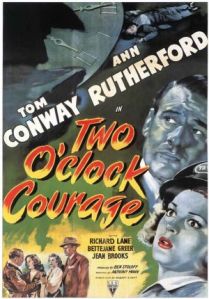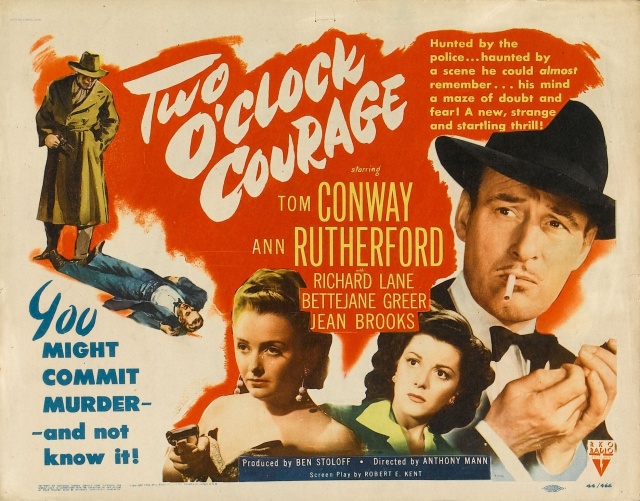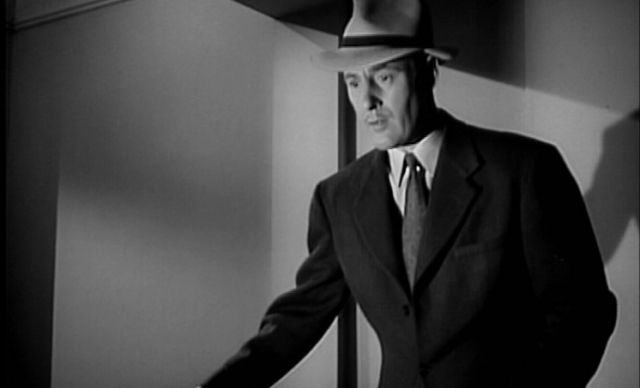 Something of a forgotten semi Noir, this mixture of comedy and thrills marked the RKO debuts of director Anthony Mann and Jane Greer (here billed with her full name, ‘Bettejane’). The leading man is Tom Conway, already established at the studio thanks to notably dark performances in such distinctive Val Lewton chillers as Cat People (1942), I Walked with a Zombie (1943) and The Seventh Victim (1943). Here he plays an amnesiac trying to figure out whether he is or is not responsible for a murder. Unlike the sombre Lewton films, the tone is light and convivial, more in tune with the silky smooth persona Conway projected in his long-running Falcon series as the unflappable amateur sleuth.
Something of a forgotten semi Noir, this mixture of comedy and thrills marked the RKO debuts of director Anthony Mann and Jane Greer (here billed with her full name, ‘Bettejane’). The leading man is Tom Conway, already established at the studio thanks to notably dark performances in such distinctive Val Lewton chillers as Cat People (1942), I Walked with a Zombie (1943) and The Seventh Victim (1943). Here he plays an amnesiac trying to figure out whether he is or is not responsible for a murder. Unlike the sombre Lewton films, the tone is light and convivial, more in tune with the silky smooth persona Conway projected in his long-running Falcon series as the unflappable amateur sleuth.
The following review is offered as part of the Tuesday’s Overlooked Film meme hosted by Todd Mason over at his Sweet Freedom blog and you should head over there to see the many other fascinating titles that have been selected.
“What city are we in?”
“You don’t know what city we’re in? Wait until the Chamber of Commerce hears about this!”
This film is based on the Depression-era novel of the same name by Gelett Burgess (Richard Lupoff reprinted it with a new introduction for Ramble House in 2009 and I’ll be reviewing it here soon), which had already been filmed by the studio in 1936 as Two in the Dark (directed incidentally by Ben Stoloff, the producer of this remake). This version opens impeccably with a black screen out of which walks a stumbling shape. He staggers towards a street sign, then sags – all shot in one continuous take, the camera then tracks up to see the top of the street sign, the corner of Ocean View and Arch Street, before tracking back down again – we now see that the man (Conway) is bleeding from the side of his head. He steps out into the street and we cut for the first time as he is almost run over by a cab.

Cue the entrance of Ann Rutherford as Polly, the bubbly cab driver (think of Betty Garrett in On the Town and then lower the caffeine level down a notch and you’re there). The driver is initially unimpressed and takes him for a drunk but quickly realises that the man has been hurt. He can’t remember his name or anything else – all he knows is that his hat has the initials RD (or DR) on it, he has two stubs from a Broadway show, $500 in cash and a matchbook from the Blue Room at the Regency Hotel. They head to the police station, but learn from a newseller outside that Robert Dilling (i.e with the same two initials as Conway’s hat) was killed in the spot where Conway was found bleeding – and that $500 was taken. The police have put out a bulletin for Dave Rennick (those two initials again), Dilling’s chauffeur who matches Conway’s general description, including his pinstripe suit. Polly has taken a shine to her bewildered passenger, and doesn’t think he looks like a driver (and she should know), so she helps him get a new suit and then goes to visit the home of Rennick.
It turns out that Dilling, the producer of the Broadway play ‘Menace’, had been taking half of the author’s share of the profits. Conway also finds the manuscript of another play, Two O’Clock Courage by Lawrence Tenny but doesn’t get a chance to look at it. By this point Conway and Rutherford are masquerading as Mr and Mrs Clarence Smith to steer clear of a double act made up of hardboiled reporter Haley (Richard Lane) and Emory Parnell’s surprisingly amiable police detective (the two are even on a first name basis). All these scenes are played strictly for laughs, the tone remaining chucklesome for the nest 20 minutes or so as Conway and Rutherford try to clear his name (and find it too). Rutherford gets into a slinky nightgown, outfoxes her nosy landlady and accompanies Conway to the Regency Hotel where he meets several friends of his. Thus we learn that our hero is actually named Theodore ‘Step’ Allison, is an old school friend of Mark Evans, author of ‘Menace’ and is fairly cosy with Helen Carter (Greer), who immediately becomes jealous of Polly. Mark and Step used to know Lawrence Tenny, who apparently committed suicide not long before. Mark then gets into a fight with Maitland, the boyfriend of Barbara Borden (Jean Brooks), star of ‘Menace’. Greer is great in these scenes in full-fledged sultry mode though her inexperience shows later on when she is called to play a sloppy sentimental drunk and is much too broad.

The police however are closing in on Step once Barbara tells the police that he had an appointment with Dilling the night of the murder. ‘Step’ goes back to the scene of the crime for a highly atmospheric sequence, the first that really ties stylistically with the impressive opening of the film. He enters the house at night through a window with only a flashlight to see by and finds Tenny’s manuscript for the play ‘Two O’Clock Courage’ – but he is being observed and is shot. The MS is take while he lies unconscious – the bullet having grazed him. Predictably, this shock to our hero’s head leads to a flashback that brings back his memory. This is again very nicely staged by Mann with an extreme close-up that then actually goes in even further as we see what Step was up to and how he was bashed on the head the first time. We are now set up for the finale though the script goes to the trouble of nice double bluff with the guilty party apparently committing suicide only for this to turn out to be another murder leading to a brief but again modestly atmospheric shootout in the darkness.
We then return to lightness and Rutherford for a comedy finale – it is very noticeable how the tone shifts between the light and breezy moments with Rutherford and the darker sequences featuring only Conway. He is certainly less happy in the overtly comedic moments, especially towards the end when he finally gets arrested for murder and has to convince the police of his innocence – but on the whole Conway makes for an agreeable hero while Rutherford, like all the three of the leading ladies, looks a peach in a knockout evening dress and pushes with boundless energy. Of the three main actresses, it is Greer who probably comes off the weakest and certainly her drunken appearance in the finale is pretty amateurish – she would improve greatly and very quickly by the time she was paired again with Conway the following year in The Falcon’s Alibi. The film itself is a curious but ultimately winning combination of elements – a great little B-move that at 69 minutes never outstays its welcome
 DVD Availability: Not currently on DVD in the US, the French Editions Montparnasse release, as recommended to me by Colin of the ever-well-informed Riding the High Country blog, proves to be of better than average picture quality and with removable subtitles too. If you click on the company link you can watch the opening sequence and see what I mean about the quality of the DVD. A DVD is also available in Spain.
DVD Availability: Not currently on DVD in the US, the French Editions Montparnasse release, as recommended to me by Colin of the ever-well-informed Riding the High Country blog, proves to be of better than average picture quality and with removable subtitles too. If you click on the company link you can watch the opening sequence and see what I mean about the quality of the DVD. A DVD is also available in Spain.
Two O’Clock Courage (1945)
Director: Anthony Mann
Producer: Ben Stoloff
Screenplay: Robert E. Kent and Gordon Kahn (from the novel by Gelett Burgess )
Cinematography: Jack MacKenzie
Art Direction: Lucius O. Croxton and Albert S. D’Agostino
Music: Roy Webb
Cast: Tom Conway, Ann Rutherford, Jane Greer, Richard Lane, Jean Brooks, Lester Matthews, Emory Parnell, Roland Drew




Glad you were able to get your hands on this Sergio. Aside from the handful of scenes you mentioned – the opening, the flashback reveal – the whole thing does resemble a Falcon picture far more than a film noir, particularly with Tom Conway in the lead. Personally, I’m very fond of the Falcon movies and I like Conway’s work in this film. You’re right too about Jane Greer; she was clearly in the process of learning her craft, but her early scenes are very good indeed.
Mann had yet to hit his stride as a director, although those noirish scenes referred to do hint at the then untapped potential. Even so, it’s still a polished piece of work.
Quick question. You mention the Ramble House reprint of the original novel, do you have a copy? I’m asking because I bought the imprint’s version of Hake Talbot’s The Hangman’s Handyman some years ago, and although I was happy to get a copy of that elusive novel at all I was a bit disappointed in the small format and binding. The point is: are their editions any way improved, or at least more professional looking?
Thanks Colin, yours was an excellent suggestion as I’d never seen it before. Sounds like we are very like-minded on this one. Mann demonstrates the kind of fluidity that one would normally only associate with Joseph H. Lewis and maybe Dmytryk in RKO’s B pictures of the time so it is fascinating to see an emryonic talent start to emerge though, yes, of course, it is pretty low key, though i do like the staging in depth with has some nice echoes of Welles I thought.
As for Ramble House, I’m afiiad I got my hands on a much older edition of the book and I don’t have any of their editions but Lupoff made some interesting comments in his intro and so I decided to link to it. Sorry to have misled you on that one! What you describe sounds quite typical of what i tend to find with print-on-demand books quite often though …
No worries mate. I was just curious if RH had upped their game any although, like you say, print on demand operations tend to produce such editions.
Going back to the movie, I really like the way certain films of this period seemed able to combine genre elements so well. RKO was especially good at this, and some of their B efforts – helped of course by the pool of talent they had available – hold up remarkably well.
The theory about RKO (and later Eagle-Lion) is that as a studio without much in the way of contract artists they emphasised the technical side instead, which is how you end up with such amazingly good-lokking and well-made movies like Citizen Kane and Cat People at oppositie ends, seemingly, of the exhibitor spectrum and yet clearly with the same and identifiable house style. I was surprised by how easily the coemdy and thrills meshed in this one because the Noirish bits relly do fit in with the style while the comedy is pure screwball – not sure I’ve ever liked Ann Rutherford in anythign quite so much actually – she’s just so darn cute in this one!
Rutherford is excellent and teams up well with Conway. Any analysis of noir seems to fixate on the femme fatale roles but the Girl Friday parts are arguably just as important – the good girls who save the hero lie at the heart of many a noir. Rutherford displays great energy and good humour and really anchors this movie.
One of the great things about DOUBLE INDEMNITY is the way that Robinson gets the ‘girl friday’ role – it would have been so easy to have given Neff a long-suffering office girlfriend to confide in – but on the other hand, especially in this case, it absolutely galvanises the movie. Though, as you rightly point out, it is well in keeping with the FALCON style to surround the protagonist with lots of beautiful women … Not that there’s anythign wrong with that!
Definitely not. I think too that the lighter overall style allows for more female parts. Your piece on The Mad Miss Manton, which originally got us talking about this movie, shows how that picture offers similar opportunities.
Actually the comparison with Manton does also tend to show up the kind of stock characters that recur a lot in these sorts of films like the hardboiled journalist, the inspector who tends to get flustered, the society ladies with somethign to hide with plots that have a tendency to follow the treasure hunt structure with a McGuffin being chased throughout. Still a lot of fun though …
Yeah, stock characters and situations they may be but that doesn’t mean they’re any less entertaining.
In fact, quite the opposite …
i think I remember Ann Rutherford most for the Andy Hardy movies and, of course, GWTW. She just died-I think the last major character from that film. Perhaps not. I have never heard of this one but it looks fun. I am sure it won’t turn up any time soon on TCM but I will place it on LOCATE.
Hi Patti – TCM has clips and a trailer here. Rutherford was certainly one of the very last actors from GWTW though Olivia de Havilland is still around thankfully.
Sergio – Thanks as ever for an interesting and well-written review. I wondered whether Conway’s persona here would be anything like his portrayal of the Falcon character… It’s not easy to tell a very dark story like this one with a light touch and I’m glad that balance worked for you. I hope this one’s available for U.S. audiences soon.
Cheers Margot. It does seem odd that thisis one of those fairly straightforwrd films that is available only in Europe at the moment – can’t imagine why. It is certainly Falcon-esque (sic) but Conway at least gets to play around with the formula a bit.
I had a copy of this book a long time ago but sold it before I read it. Wish I had now. Never knew it was a movie. I like some of Mann’s early movies when he was showing real cinematic talent. RAILROADED! is an odd one with Hugh Beaumont (the future Beaver Cleaver’s Dad) as an unlikely hero. So too is STRANGE IMPERSONATION which unfortunately has a cop out ending that ruined it for me. A much later movie in his career when he was really at the height of his powers is NAKED SPUR, one of my favorite movies of all time and one of the better noir Westerns.
Not mentioned above (but I’m sure you know already) is the fact that Tom Conway was George Sanders’ brother. I love that Conway took over as the Falcon when his brother tired of the series. Speaking of the Falcon — I found one of the original books from that series. A review is coming soon to Pretty Sinister Books.
Cheers John – I had no idea there were Falcon books other than the Michael Arlen short story – really looking forward to that. Actually, I’d originally mentioned in the post that Conways played not the Falcon but his brother and then cut it as it seemed a bit extraneous – which, considering what my posts are like, seems in retrospect to have been an odd decision on my part … Mann was a major talent of the 40s and 50 and I love all his Noirs, even theones he worked on without credit like He Walked By Night where his influence is quite clear.
Sergio, I’m absolutely in the dark about this film or its cast or even the book by Gelett Burgess on which it is based. I might add, though, that Tom Conway in the coloured poster looks familiar to me and it’s possible I might have seen him in one or the other film. This seems like the kind of film I’d catch accidentally while switching channels.
Hi Prashant – well, Tom Conway did look quite a lot like his brother, George Sanders, so that might also be the reason. But he made a couple of dozen movies at RKO in the 40s and most of the m are really good fun. He was born into a noble Russian family who left after the 1917 revolution and then became more English than the English. I attach a photo of the two of them from The Falcon’s Brother and a clip of Comnway from The Falcon in Danger
